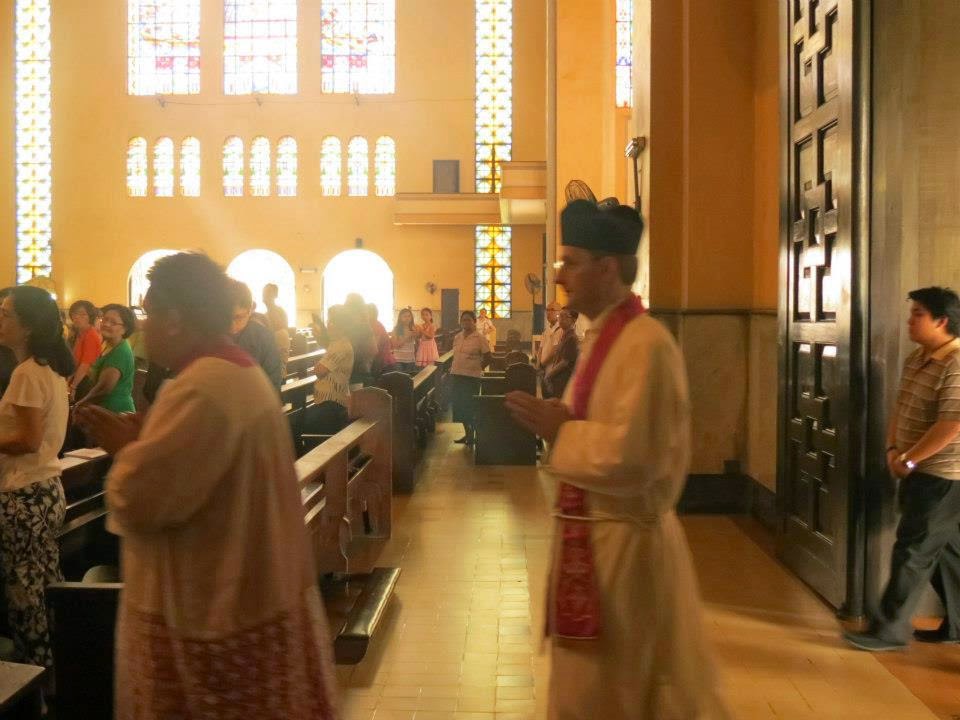St. Augustine's portrait that hangs at the clausura (cloister)
The titular patron is actually St. Paul (you know, the epistles? the love is patient,love is kind guy. he is the one) Why then it became San Agustin? Well (according to an old TV series I watched) it just happened that people like to call it that way because of the Augustinian friars there. that's all. yeah, not much of a story no? Maybe because Filipinos back then are used to call the mother churches of the different religious orders at Intramuros by their titulars (which most of the time is the founder of the order). Ok, let us leave it that way. The friars seems to enjoy devotions to Holy Father Augustine being propagated that way so be it.
Being a student within the confines of Intramuros, San Agustin is towering with its then orange paint. i longed to visit it actually but whenever I will by, its either its close or a wedding is being held inside. My first time to enter it is by an accident. June 24, 2011 is Araw ng Maynila. We are asked to go to Bonifacio Monument near Manila City Hall for a mass but the weather is behaving in uneasy mood and so the organizers moved it there. What is the connection of it with Manila's history? It just happened that Miguel Lopez de Legaspi, El Adelantado, is buried there. Oh by the way, he is the founder of Manila. Long story short, I got the chance to enter San Agustin but not the famed museum. It could wait anyway
Waiting...
So that great day came, I guess its examination week so i got plenty of time exploring the museum. My jaw dropped at the ivory figures, the age old books, the regal trompe l'oeil ceiling and other wonderful ecclesiastical treasures. It contains great variety of stuffs and trinkets of interest. I won't say it, better find it for yourselves dear readers, i'll just present some ;)
trompe l'oeil ceiling details
Silver works
an old tabernacle
honestly I do not know what this is. is it a lavabo dish? or maundy dish?
this one too. anyone can identify these?
Paintings
Martyrdom of an Augustinian priest. I believe he is Canonized or atleast beatified.
San Agustin Museum holds a vast collection of paintings and works of art. Its mostly religious in nature and portrays the martyrdom and greatness of the Augustinians in their missionary works. Most of the time, the said martyrdom paintings involved priests being impaled, crucified and like the one above, burned alive.
The best part of the museum/church tour is the Choir area. the Augustinians preserved a wonderful organ and a large cantorale with the original vellum (or parchment?) chantbooks. There is a legend that a friar was killed by another friar during the Spanish times and to determine who the culprit is, they hang the friar's corpse; with his finger extended and pointing, in the sentry of the choir which, by the way, they use for the Divine Office, and whoever exhibits "signs of guilt" is the killer. i do not know what signs they are looking for but it made my experience quite creepy. Also, one of the greatest Filipino musician, Marcelo Adonay also worked here as conductor and during his childhood, a tiple (choirboy)
A chapel before the choir. It is said that friars, wanting to leave the Order must say it in choir and leave immediately thus passing here and contemplate. It then gained the reputation of being a "go or stay" cross.
Hardwood chairs, elaborately carved
Anyone knows the song? I wish its Magne Pater Augustine!
I want something like this at home. LOL
The church is a treasure chest. It gives you a perfect image of how great the Roman Catholic Church's influence and grandeur back then. It encompasses alot of disciplines including science and the arts just like the following artifacts.
A wooden image of a saint
broken porcelain from China, perhaps from Ming dynasty
Priestly vestments. Imagine the number of items they need to wear whenever offering the Mass during the summer season. Whew!
Famed book, Flora de Filipinas, written by renowned Fr. Blanco, OSA
One more place that may mark your cerebrum is the crypt. Here lies many Filipino, Spanish and foreigners belonging to the alta sociedad (elite class). this is a location of murders and tortures during World War 2. It really made my hair rise and look for the escape quickly (hey,i'm alone inside the crypt then with long dead persons!) . Some famous persons interred here are painter Juan Luna and pedro Paterno. those rich enough to afford a personal chapel or atleast famous enough is interred at the church' side chapels. When you entered San Agustin, you may be stepping on a gravestone without knowing it. The rich merchants Zobel de Ayalas are some buried at the side chapels.
Visiting San Agustin is a wonderful experience. Walking along the very same corridors where friars, prince and princes (then Prince Juan Carlos and Sofia of Spain visited the museum) and many others gives you a sense of pride being a Catholic but also a hint of bitterness with the great loss we had back then. the rooms where the friars processed singing De Profundis for a dead brother, the one used by Gov. Gen. Fermin Jaudinez to draft the terms of surrender to the British and those tiles sanctified by great Filipino talents, labors and devotions through time. I pray to God that someday, intramuros, the Paris of the East, will be resurrected and like the phoenix, rise from the ashes.
One last thing, a Fu dog! a chinese symbol of evil dispelling creature (which is like a shih tzu) guards the Church. A dear friend, Fr. Norlito Concepcion, OSA told me that the Spanish friars really want gargoyles but when the chinese artisan delivered his work, poof! fu dog arrived.

















.jpg)













